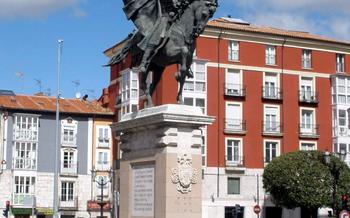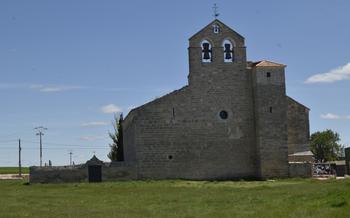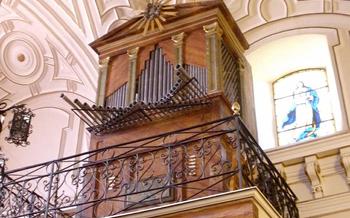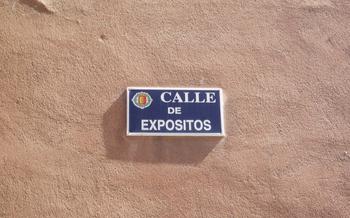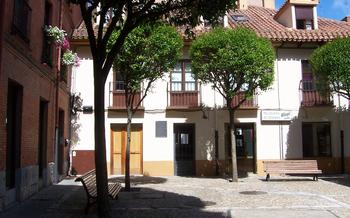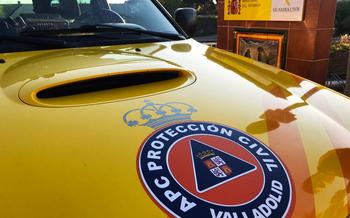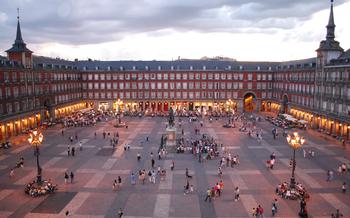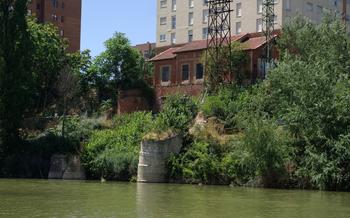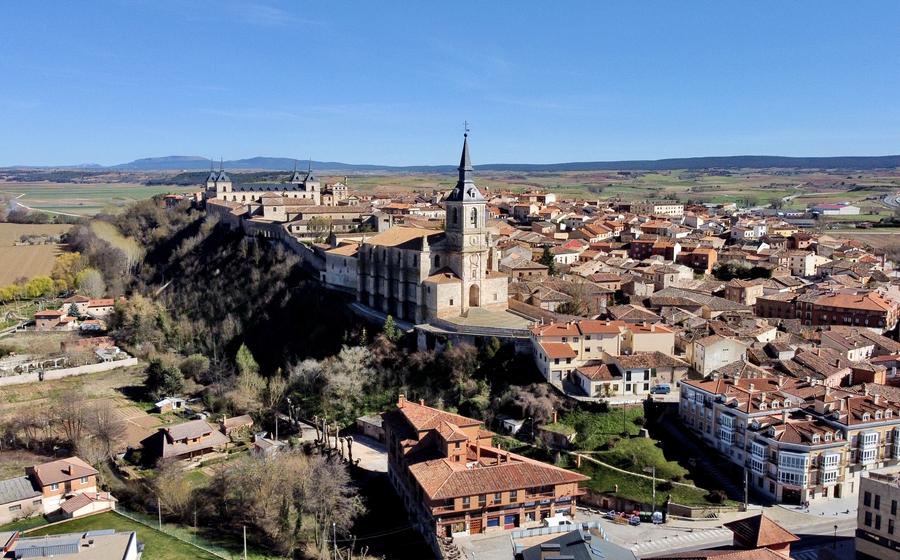
Lerma
- Lerma, a Historical Gem in the Heart of Spain
- Ducal Palace of Lerma: A Grandeur of Renaissance Architecture
- Colegiata de San Pedro: A Gothic Masterpiece
- Plaza Mayor: The Heart of Lerma's Bustling Town Square
- Museo de Arte Contemporáneo: A Modern Art Haven
- Monastery of San Blas: A Spiritual Retreat
- Ermita de la Virgen del Carrascal: A Pilgrimage Site
- Local Cuisine: Savoring the Flavors of Lerma
- Wine Tasting in Lerma: A Journey Through Ribera del Duero
- Festivals and Events: Celebrating Lerma's Cultural Heritage
- Outdoor Activities: Exploring Lerma's Natural Surroundings
- Shopping in Lerma: Unique Souvenirs and Local Crafts
- Accommodation Options: Finding Your Home Away from Home
- Insider Tip: Discovering Hidden Gems Off the Beaten Path
Lerma, a Historical Gem in the Heart of Spain
In the heart of Spain's Castile and León region lies the enchanting town of Lerma, a historical gem steeped in rich heritage and architectural wonders. Founded in the 11th century, Lerma flourished under the patronage of the powerful Dukes of Lerma, who transformed it into a magnificent ducal seat during the 17th century. Today, Lerma stands as a testament to its noble past, inviting travelers to explore its elegant palaces, Gothic churches, and charming town square.
Situated in the province of Burgos, Lerma boasts excellent accessibility by road and rail. It is conveniently located just an hour's drive from the city of Burgos and well-connected by bus and train services. Whether you're a history buff, an art enthusiast, or simply seeking a tranquil escape, Lerma offers a delightful experience all year round.
While the town is captivating in every season, spring (April-May) and autumn (September-October) offer particularly pleasant weather for strolling its cobblestone streets and admiring its architectural treasures. Avoid the sweltering summer heat and the chilly winter months for a more comfortable visit.
My first encounter with Lerma was serendipitous. During a road trip through Spain, I stumbled upon this hidden gem and was immediately captivated by its charm. The town's harmonious blend of Renaissance and Gothic architecture, combined with its tranquil atmosphere, left an indelible mark on my memory. Lerma is a place where history comes alive, and I highly recommend it to anyone seeking an authentic Spanish experience.
Ducal Palace of Lerma: A Grandeur of Renaissance Architecture
The Ducal Palace of Lerma, a majestic symbol of Renaissance architecture, stands as a testament to the town's rich history. Built in the 17th century by the powerful Duke of Lerma, Francisco Gómez de Sandoval, the palace exudes an aura of grandeur and opulence. Its imposing facade, adorned with intricate carvings and sculptures, hints at the treasures that lie within.
Step inside the palace and be transported back in time as you wander through its grand halls and galleries. The grand staircase, a masterpiece in itself, sweeps upwards, inviting you to explore the palace's opulent interiors. Admire the intricate tapestries that adorn the walls, each telling a story from the palace's past. The Salón del Trono, once the seat of power for the Duke of Lerma, is a sight to behold, with its ornate ceiling frescoes and exquisite furnishings.
During my exploration of the palace, I was particularly captivated by the Hall of Mirrors, a room of shimmering elegance. The countless mirrors, reflecting the light that streams through the grand windows, create an enchanting kaleidoscope effect. It's easy to imagine the palace's former inhabitants hosting lavish parties and entertaining guests in this magnificent setting.
The Ducal Palace of Lerma is not just a historical landmark but also a living testament to the artistry and craftsmanship of the Renaissance era. Its grandeur and opulence are sure to leave a lasting impression on every visitor.
Colegiata de San Pedro: A Gothic Masterpiece
The Colegiata de San Pedro, standing tall and proud in the heart of Lerma, is a testament to the town's rich history and architectural brilliance. Its Gothic grandeur is evident in every intricate detail, from the soaring spires that pierce the sky to the graceful arches that frame its majestic entrance.
Step inside the sacred space, and you'll be transported back in time. The air is filled with an aura of reverence as sunlight streams through the stained-glass windows, casting a kaleidoscope of colors onto the grand interior. Gaze upon the intricately carved choir stalls, each adorned with unique motifs that tell tales of faith and devotion.
Among the many treasures housed within the Colegiata, the Gothic altarpiece stands as a masterpiece of artistic craftsmanship. Its intricate carvings depict scenes from the life of Christ and the saints, each figure imbued with a sense of realism and emotion that is both awe-inspiring and humbling.
Take the time to explore the side chapels, each dedicated to a different saint or religious order. Here, you'll find an array of stunning artworks, including paintings, sculptures, and goldsmithing that showcase the artistic prowess of the era.
If you're fortunate enough to be in Lerma during Holy Week, make sure to attend a mass or religious ceremony at the Colegiata. The atmosphere is truly magical, with the sound of Gregorian chants filling the air and the flicker of candlelight illuminating the grand interior. It's an experience that will stay with you long after you've left Lerma.
Plaza Mayor: The Heart of Lerma's Bustling Town Square
The Plaza Mayor, the beating heart of Lerma, is a stunning testament to the town's rich architectural heritage and vibrant community spirit. This grand square, with its arcaded porticoes and elegant buildings, exudes a timeless charm that draws visitors and locals alike.
The plaza's architecture showcases a harmonious blend of Renaissance and Baroque styles, reflecting Lerma's golden age. The uniform facades of the surrounding buildings, adorned with intricate stone carvings and wrought-iron balconies, create a sense of unity and grandeur.
Throughout history, the Plaza Mayor has served as the town's main gathering place, hosting markets, festivals, and other significant events. Even today, the square bustles with activity, with locals and tourists mingling in its lively atmosphere.
During my visit to Lerma, I spent many delightful hours in the Plaza Mayor, soaking in its vibrant energy. Whether savoring a leisurely coffee at one of the charming cafés or browsing the stalls of a bustling market, I felt a deep connection to the town's rich history and vibrant present.
One evening, as the sun cast a warm glow over the square, I witnessed a traditional dance performance that showcased the town's cultural heritage. The rhythmic music, colorful costumes, and lively steps of the dancers created a magical atmosphere that left me spellbound.
Museo de Arte Contemporáneo: A Modern Art Haven
Housed in a striking modern building, the Museo de Arte Contemporáneo is a testament to Lerma's commitment to preserving and showcasing contemporary artistic expressions. Its collection boasts an impressive array of works from renowned Spanish and international artists, spanning various mediums and styles.
The museum's architecture, a harmonious blend of modern and traditional elements, creates a unique backdrop for the diverse exhibits. Natural light floods the spacious galleries, illuminating the artworks and enhancing the immersive experience for visitors.
Among the notable pieces to look out for are thought-provoking sculptures, vibrant paintings that capture the essence of modern life, and interactive installations that invite viewers to engage with the art on a deeper level. The museum also hosts temporary exhibitions, offering a platform for emerging artists to showcase their innovative creations.
During my visit, I was particularly drawn to a captivating abstract painting that seemed to shift and change before my eyes, evoking a sense of wonder and intrigue. It was a reminder of the power of contemporary art to challenge perceptions and spark meaningful conversations.
Monastery of San Blas: A Spiritual Retreat
Nestled amidst the tranquil landscapes of Lerma, the Monastery of San Blas stands as a testament to the town's rich religious heritage. Founded in the 10th century, this architectural marvel boasts a blend of Romanesque and Gothic styles, showcasing the evolution of architectural prowess over the centuries. As you step through its ancient gates, the monastery's serene atmosphere envelops you, inviting you to embark on a journey of spiritual introspection.
Beyond its imposing facade lies a world of intricate details and sacred treasures. Admire the monastery's beautifully preserved cloister, where graceful arches and delicate carvings narrate tales of devotion and artistry. Within the church, marvel at the intricately carved choir stalls, each depicting biblical scenes with remarkable precision. The monastery's collection of religious artifacts, including sacred relics and ancient manuscripts, offers a glimpse into the deep faith and traditions that have shaped Lerma's history.
The Monastery of San Blas is not merely a historical monument; it is a living testament to the enduring power of spirituality. Throughout the year, the monastery hosts religious services, retreats, and workshops, providing opportunities for visitors to connect with their inner selves and find solace in the embrace of faith. Whether you are a pilgrim seeking spiritual guidance or a curious traveler eager to delve into the depths of Lerma's heritage, the Monastery of San Blas awaits you with open arms.
Ermita de la Virgen del Carrascal: A Pilgrimage Site
Nestled amidst the picturesque landscapes of Lerma, the Ermita de la Virgen del Carrascal stands as a testament to the town's deep-rooted religious traditions. This charming hermitage, with its simple yet elegant architecture, is dedicated to the Virgin of Carrascal, a revered figure in local folklore.
Legend has it that in the 13th century, a shepherd boy named Juanillo witnessed a miraculous apparition of the Virgin Mary while tending his flock in the surrounding hills. At the site of this divine encounter, a small chapel was erected, and over time, it evolved into the present-day hermitage.
Throughout the year, the Ermita de la Virgen del Carrascal attracts pilgrims and visitors seeking spiritual solace and connection with the sacred. The annual pilgrimage, held on the first Sunday of May, is a particularly significant event, drawing thousands of devotees who converge on the hermitage to pay homage to the Virgin Mary.
During this special occasion, the streets of Lerma come alive with a vibrant procession, where locals and pilgrims carry the statue of the Virgin through the town, accompanied by music, prayers, and a palpable sense of devotion. The festivities culminate with a solemn mass held within the hermitage, an experience that leaves a lasting impression on all who partake.
Whether you're a devout pilgrim seeking spiritual renewal or simply a curious traveler drawn to the allure of religious traditions, the Ermita de la Virgen del Carrascal is a must-visit destination in Lerma.
Local Cuisine: Savoring the Flavors of Lerma
Lerma's culinary scene is a delightful blend of traditional Castilian cuisine and modern culinary influences, offering a diverse range of flavors and dishes to satisfy every palate.
For an authentic taste of Lerma, be sure to try the asado de cordero (roast lamb), a succulent dish prepared with tender lamb slowly roasted over an open fire, resulting in a crispy exterior and a juicy, flavorful interior. Another local specialty is the morcilla de Burgos (blood sausage), a rich and savory sausage made with pork blood, rice, and spices.
When it comes to restaurants, Lerma offers a variety of options, from traditional Spanish taverns to modern fusion restaurants. For a truly memorable dining experience, head to Casa Villota, a renowned restaurant housed in a charming 17th-century building. Here, you can indulge in innovative dishes that showcase local ingredients and modern culinary techniques.
For a more casual dining experience, try El Mesón de la Villa, a cozy tavern that serves up traditional Spanish tapas and hearty stews. Don't miss the croquetas de jamón (ham croquettes), a classic Spanish dish made with creamy béchamel sauce and crispy fried ham.
Insider Tip: Be sure to try Lerma's Queso de Oveja (sheep's milk cheese), a local specialty known for its rich flavor and creamy texture. Pair it with a glass of local wine for a truly delightful experience.
Wine Tasting in Lerma: A Journey Through Ribera del Duero
Lerma lies at the heart of the renowned Ribera del Duero wine region, a land blessed with vineyards that produce some of Spain's most exceptional wines. The region's unique climate, soil conditions, and grape varieties combine to create a distinctive and highly acclaimed style of wine.
For wine enthusiasts, a visit to Lerma presents an opportunity to embark on a journey through the flavors and aromas of Ribera del Duero. Numerous wineries and vineyards in the area welcome visitors for wine tasting experiences, offering a chance to sample the region's finest vintages.
Among the notable grape varieties grown in Ribera del Duero is the Tempranillo, known for its intense fruit flavors, firm tannins, and aging potential. Wineries such as Bodegas Emilio Moro, Bodegas Vega Sicilia, and Bodegas Protos are renowned for their exceptional Tempranillo-based wines.
During a wine tasting session, visitors can learn about the winemaking process, the unique characteristics of Ribera del Duero wines, and the passion that drives the local winemakers. Whether you're a seasoned wine connoisseur or a curious beginner, the experience of tasting these world-class wines in the heart of their birthplace is truly unforgettable.
In one memorable wine tasting session, I had the privilege of conversing with a local winemaker who shared his insights into the art of winemaking and the history of Ribera del Duero. As I sipped on a glass of velvety Tempranillo, I couldn't help but feel a deep appreciation for the dedication and craftsmanship that goes into each bottle of this exceptional wine.
Festivals and Events: Celebrating Lerma's Cultural Heritage
Lerma comes alive during its annual festivals and events, which showcase the town's rich cultural heritage and traditions. The most notable celebration is the Fiestas de San Blas, held on February 3rd, honoring the town's patron saint. The festivities include colorful processions, traditional dances, and a lively fair with music, food, and entertainment.
During Semana Santa (Holy Week), Lerma transforms into a solemn and spiritual destination. The town hosts elaborate processions, where participants dressed in traditional robes carry religious icons through the streets. The atmosphere is both somber and deeply moving, offering a unique glimpse into Spain's religious traditions.
Throughout the year, Lerma also hosts various cultural events, concerts, art exhibitions, and workshops. These events provide opportunities to experience the town's vibrant artistic scene and connect with local artisans and performers.
Whether you're interested in religious traditions, music, art, or local culture, Lerma's festivals and events offer something for everyone. Be sure to check the town's calendar before your visit to plan your trip around these special occasions.
Anecdote:
I had the privilege of attending the Fiestas de San Blas during my visit to Lerma. The town was abuzz with excitement, and the streets were adorned with colorful decorations. I joined the procession, marveling at the intricate costumes and the devotion of the participants. The air was filled with the sound of music, laughter, and the sweet aroma of churros and chocolate. It was a truly unforgettable experience that left me with a deep appreciation for Lerma's vibrant cultural heritage.
Outdoor Activities: Exploring Lerma's Natural Surroundings
Lerma is not only about its historical and cultural treasures; it is also surrounded by a beautiful natural landscape that invites outdoor enthusiasts to explore its hidden gems. Whether you prefer leisurely strolls or challenging hikes, Lerma has something for everyone.
One of the most popular hiking trails is the Ruta de los Molinos, a scenic 8-kilometer loop that takes you through the stunning countryside, passing by old mills and water channels. Along the way, you can admire the panoramic views of the town and the surrounding mountains.
For a more challenging hike, climb up to the Pico del Águila, the highest point in the area, which rewards you with breathtaking views of the entire region. The trail is well-marked and offers several resting points along the way.
If you prefer cycling, there are several bike rental shops in Lerma where you can rent a mountain bike and explore the many trails and paths in the surrounding hills. You can also embark on a horseback riding tour, which is a great way to experience the beauty of the countryside and interact with the local wildlife.
After a day of exploring, unwind and relax in one of the many natural springs or swimming pools in the area. The Piscinas Naturales del Arlanza are a popular choice, offering a refreshing dip in the cool waters of the Arlanza River.
Shopping in Lerma: Unique Souvenirs and Local Crafts
Lerma is a treasure trove for shoppers seeking unique souvenirs and local crafts. The town is home to several charming shops and markets where you can find handmade pottery, textiles, and other artisanal products.
One of the best places to start your shopping adventure is the Mercado Municipal de Lerma, a traditional market located in the heart of the town. Here, you can browse stalls selling fresh produce, local cheeses, and handmade crafts. You're sure to find something special to take home as a souvenir.
For a more curated shopping experience, head to the Calle Mayor, where you'll find boutiques and shops selling a variety of unique items. From handmade jewelry to traditional Spanish clothing, you're sure to find something to your taste.
Be sure to keep an eye out for local pottery, which is a specialty of Lerma. The town is home to several skilled potters who create beautiful and unique pieces. You can find everything from decorative plates to functional cookware, all handmade with care.
Another must-buy souvenir from Lerma is the local textile, known as "paños de Lerma." These colorful and intricately patterned fabrics are made from natural fibers and are used to create a variety of products, including blankets, scarves, and tablecloths.
Whether you're looking for a unique souvenir or a special gift, you're sure to find something to your liking in Lerma. So be sure to set aside some time to explore the town's shops and markets during your visit.
Accommodation Options: Finding Your Home Away from Home
When planning your stay in Lerma, you'll find a range of accommodation options to suit every budget and preference. From charming guesthouses to modern hotels, there's something for every traveler. For a truly immersive experience, consider staying in a traditional Spanish parador, a historic building that's been converted into a hotel.
To ensure a comfortable stay, it's advisable to book your accommodations in advance, especially if you're visiting during peak season. Online booking platforms and travel agencies can help you find the best deals and availability.
I had the pleasure of staying at a cozy hotel in the heart of Lerma's historic center. The warm hospitality and attention to detail made my stay truly memorable. The hotel's charming courtyard and rooftop terrace offered breathtaking views of the town and surrounding countryside.
Whether you prefer the convenience of a modern hotel or the rustic charm of a traditional guesthouse, Lerma has something to offer every traveler. Embrace the town's unique atmosphere and find your home away from home in this enchanting destination.
Insider Tip: Discovering Hidden Gems Off the Beaten Path
Beyond the main attractions, Lerma holds a treasure trove of hidden gems waiting to be discovered. For those willing to venture off the beaten path, here's an insider tip: explore the picturesque alleys and courtyards that branch off from the Plaza Mayor. These charming hidden corners often reveal architectural details, small chapels, or tranquil squares that capture the essence of Lerma's rich history.
One such hidden gem is the Calle del Pez, a narrow cobbled street lined with beautifully preserved medieval houses. Take a leisurely stroll along this street, admiring the intricate stone carvings and wrought-iron balconies that adorn the facades. At the end of the street, you'll find the Iglesia de Santa Clara, a small but stunning Romanesque church that dates back to the 12th century.
Another hidden gem is the Convento de las Carmelitas Descalzas, a secluded convent located on the outskirts of Lerma. This tranquil oasis is home to a community of Carmelite nuns who live a life of prayer and contemplation. Visitors are welcome to attend mass in the convent's chapel, which is decorated with beautiful frescoes and intricate carvings.
Whether you're seeking hidden architectural gems, serene religious spaces, or simply a peaceful escape from the tourist crowds, Lerma's hidden gems offer a unique and authentic glimpse into the town's rich history and culture.
